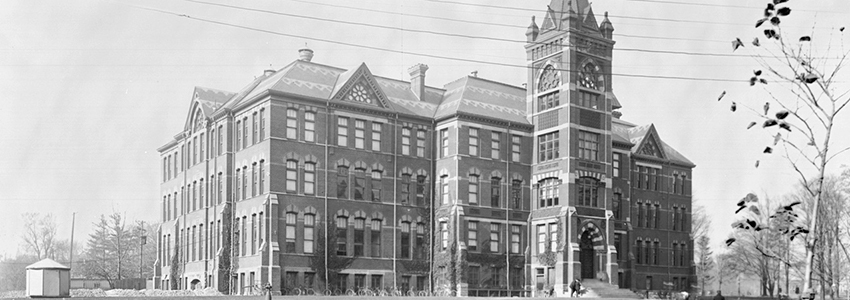History of Mechanical Engineering at U of T

Mechanical Engineering
The Department of Mechanical Engineering was developed as a specialization in 1890, within the School of Practical Science (SPS), established in 1871. The first five Departments thus established were Civil, Mechanical, Architecture, Applied Chemistry and Mining Geology. In 1906 the Department became independent of other disciplines and specialized in hydraulic engineering, heat engineering, machine design and electrical engineering. Electrical Engineering became an independent Department in 1913.
A long-standing commitment to hydraulic and open-channel flows was spearheaded by Professor Robert Angus (1873-1960), the first Professor of Mechanical Engineering and Head of the Department for many years (1907-1944). Building facilities in Mechanical Engineering witnessed two expansions: one in 1908 (The “Old Wing”) and a second major expansion in its present building in 1947 (The “New Wing”).
History of Degree Granting
- 1890: A three-year undergraduate Mechanical Engineering Diploma. First recipient: R. A. Ross in 1890.
- 1893: The first BASc degree was awarded to W. A. Lea.
- 1913: The MASc program was introduced and awarded to W.P. Dobson in 1916.
- 1927-28: The PhD program was established.
- 1939: The first PhD degree was conferred to G. Ross Lord (3rd Head of the Department) for his thesis entitled: "Investigation of Cavitation in Water with regard to Machines".
- 1967: The MEng Degree program was introduced.
Past Chairs of the Department of Mechanical Engineering:
- Professor Robert Angus (1873-1960)
Industrial Engineering
Industrial Engineering has its roots in the Engineering and Business program (1946-1959) within the Mechanical Engineering Department. The new Head, Professor E. A. Allcut, encouraged the growth of the discipline as he himself had substantial industrial experience and interest in scientific management. Professor Allcut instituted the new program which sought to combine the industrial engineering and management principles.
The eventual cessation of Engineering and Business came not from a lack of student interest or future employment opportunities, but from academic concerns. There was recognition that a four-year program could not do justice to the study of either engineering or business. As well, postgraduate study in business (MBA) was becoming increasingly popular among graduates in the various engineering specialties.
In place of Engineering and Business evolved a new program: Industrial Engineering. This was in no manner the simple joining of business skills with engineering. It was the application of engineering approaches and a scientific mindset to problems of industrial management. It is based on the principal that complex operations involving a variety of human, technical, and economic factors can be formulated as a programming problem and optimized using mathematical techniques. Industrial management problems can thus be engineered in the same was as water system or electrical grid.
The new course in Industrial Engineering first appeared in the FASE calendar for the 1959/1960 session. Students in Engineering and Business with more than one year of study remaining were transferred into it. Thus, the final graduating class in Engineering and Business was in 1960. The first class to graduate in Industrial Engineering was in 1961.
Past Chairs of the Department of Industrial Engineering:
- Professor Arthur Porter
- Professor Ben Bernholtz
The Department of Mechanical & Industrial Engineering
On June 30, 1995, Professor Andrew Jardine reached the end of his term of office as Chair of the Department of Industrial Engineering. Upon taking advice, then Dean of Engineering, Professor Michael Charles, announced his intention to seek approval for the merger of the Department of Industrial Engineering with the Department of Mechanical Engineering to form a new Department: the Department of Mechanical & Industrial Engineering. Consequently, instead of appointing a new Chair of the Department of Industrial Engineering he appointed Professor Iain Currie, the Chair of the Department of Mechanical Engineering, as the Acting Chair of the Department of Industrial Engineering..
The rationale for this bold and controversial move was based essentially on logistical considerations which were precipitated by financial issues. The Province of Ontario had severe budgetary problems at that time, and spending on sectors such as education and health was severely restricted. For a Department like Industrial Engineering, this posed a serious problem. The Department’s areas of interest and expertise were expanding at the same time as the financial resources to sustain such expansion were diminishing.
The primary concern of the Faculty of Applied Science & Engineering was the future of the program in Industrial Engineering. It was Dean Charles’ intention to help to sustain the program by shedding some of the administrative duties associated with operating a Department, as well as to capitalize on potential synergies resulting from a merger with Mechanical Engineering. That is, the proposed new Department of Mechanical & Industrial Engineering would serve as a single administrative unit for two distinct programs – one in Mechanical Engineering and one in Industrial Engineering. Such administrative arrangements are not unique in North America, and several universities have a single Department which administers mechanical and industrial engineering, and some also include aerospace engineering and/or materials engineering. It was an objective of the merger to combine classes in a number of fundamental undergraduate courses to help relieve the teaching commitments of the program. It was also fortuitous that the two departments occupied contiguous space.
On May 1, 1996, after approvals up to and including the Academic Board, the Department of Mechanical & Industrial Engineering was born with Professor Iain Currie as the inaugural Chair.
Past Chairs of the Department of Mechanical & Industrial Engineering:
- Professor Iain G. Currie
History includes material from The Skule Story: The University of Toronto Faculty of Applied Science and Engineering, 1873-2000 by Richard White and documents from the University of Toronto archives and libraries. Thank you to Professors Andreas Mandelis and Iain G. Currie for their contributions. Professor Mandelis also cites 1890 – 1990: One Hundred years of Mechanical Engineering at the University of Toronto by Professor Emeritus Frank C. Hooper as a resource.